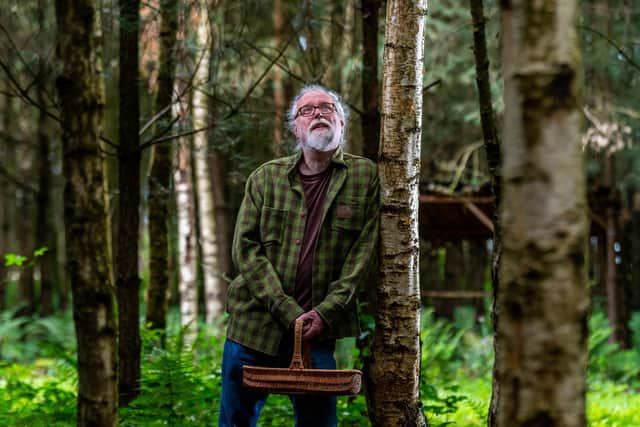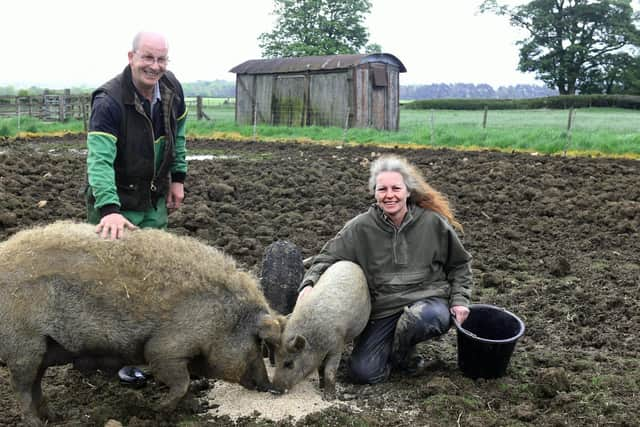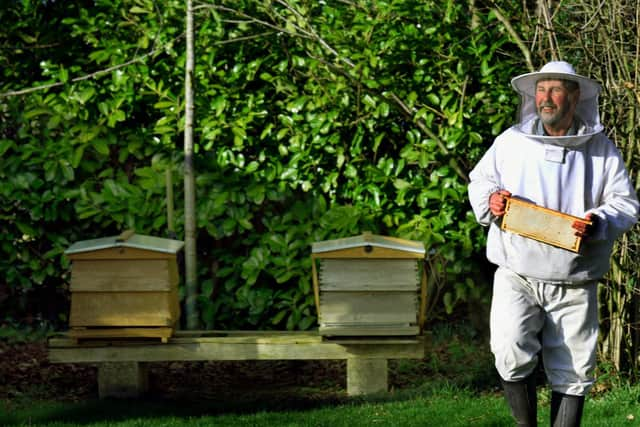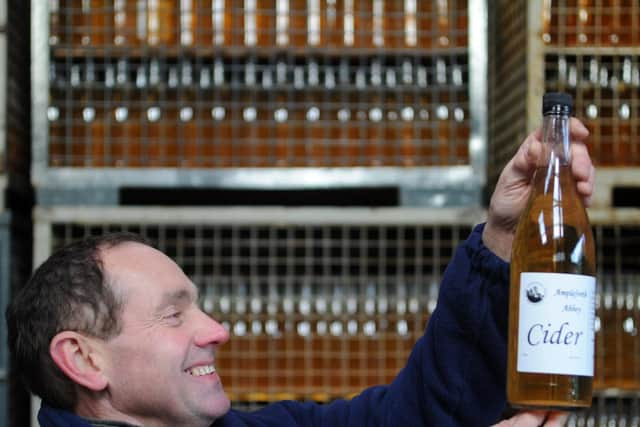The Hairy Bikers Go North: Meet the Mangalitza pig farmer, beekeeper, forager and cider maker who all appeared in the North Yorkshire episode
North York Moors-based Mangalitza pig breeder Lisa Hodgson, Westfields Honey at Fadmoor beekeeper Chris Smailes, Ampleforth Abbey cider producer Cameron Smith and forager Chris Bax all met Si King and Dave Myers in the fourth episode of the current series, which also included a visit to top chef Tommy Banks' gastropub The Black Swan at Oldstead.
Several of them have been featured in The Yorkshire Post before - here are some extracts from our articles.


Advertisement
Hide AdAdvertisement
Hide AdLisa Hodgson - Otterburn Mangalitza; the hairdresser turned pig breeder
Lisa Hodgson started her Otterburn Mangalitza herd at Low Farm, Carlton, near Helmsley nine years ago following a visit to Beamish Museum where she and her husband, Tim Otterburn, first saw what at a distance they mistook for sheep.
Lisa said she had wanted to have animals on the farm since she and Tim had got together around a dozen years ago, but that Tim had initially resisted having come out of cattle and sheep some years previously on the 210-acre farm that grows spring and winter barleys and grass for silage.
“I’m from Easington Colliery in County Durham where my dad was a miner. I’d not grown up on a farm and I told Tim I thought it was a bit of a rubbish farm without any animals.


Advertisement
Hide AdAdvertisement
Hide Ad“We’d gone to Beamish, seen these hairy pigs and I just thought they were awesome. We were told they were Lincolnshire Curly Coats, but when we came home I discovered the breed had been extinct since the 1970s.
“That’s when I found out they were Mangalitzas and I began to research them. I was really enthusiastic. I’d read about them being a slow-grown, outdoor-reared animal that you keep for over two years. That really appealed on animal welfare because it felt like we would be giving them a good life, more so than commercial pigs, but Tim initially said we weren’t having them.”
Lisa said she found a novel way around ensuring that her dream of starting the herd came about.
“After a while I decided on new tactics. I plied Tim with half a bottle of whisky and started talking about having kids again. We’d both had children from our former marriages. It did the trick. Tim said: ‘I think we’d better have them pigs instead’.”


Advertisement
Hide AdAdvertisement
Hide AdTim insisted that they would only be able to rear pigs for profit, not as pets
Tim made one stipulation to Lisa, that the pigs would not be ‘freeloading pets’ and that they would have to pay their way.
Lisa has since found new markets, come up with her own unique produce and now supplies high-end restaurants and chefs. She is also now the Mangalitza breed representative in the British Pig Association (BPA) and came up with the ‘Great Manga Move’ to help protect the bloodlines last year.
The Otterburn Mangalitza herd currently runs to 22 sows with five breeding boars and with around 130 pigs overall. She said her success with buyers has come from understanding the breed and its qualities.


Advertisement
Hide AdAdvertisement
Hide Ad“They call them the Wagyu pig because of their marbling. They began making their mark in the UK around the same time as Wagyu beef. They are made up of around 60 per cent meat and 40 per cent fat and I was told that the meat looks after itself, as it is well marbled and is less dry than other pork. The thing was to find the right product to sell the fat.
“My original intention had been to rear them on and sell as whole carcasses, but there were very few butchers who knew much about them. Marco Peerderman, head butcher for James Oliver in London, took us under his wing. He came up for a few days to look at what could be done.
“Marco designed a way of butchering that meant we could sell them in cuts, but we still needed a use for the fat.”
One of the hotels Lisa was by then supplying mentioned that they were struggling to achieve a decent black pudding. Lisa said this set her thinking.
Advertisement
Hide AdAdvertisement
Hide Ad“I got somebody to make one using Mangalitza fat in it and we found our unique product. Everyone loved it because the Mangalitza fat doesn’t leave that greasy feeling you can sometimes get with others. Ours has this lovely moisture content and is slightly sweet.
“Marco arranged for samples to be tried at a Christmas event at Sofitel Hotel in St James’s, London and we haven’t looked back. It just went absolutely bonkers with orders from chefs and restaurants.
“Our Mangalitza pork and black pudding have now been seen on all sorts of TV programmes from Saturday Kitchen to the Hairy Bikers - and our pigs have been on The Yorkshire Vet and Springtime on the Farm."
The past year has been challenging with the shutdown of the hospitality trade and Lisa reduced her breeding programme accordingly, but she is back under way now. Lisa also said the breed made history last year with the ‘Great Manga Move’.
Advertisement
Hide AdAdvertisement
Hide Ad“Every year the BPA does a survey to see how safe a breed is in terms of bloodlines. To be safe in the UK a breed needs to register a score of around 50, but the Mangalitza was at 29. I thought we really needed to do something about this.
“One bloodline, the sow line Delight, saw me as the only one in the UK who had it. My feeling was that anything could go wrong at our farm, but if it did that bloodline would be gone.
“I contacted all the 25 Mangalitza breeders in the country about doing a genetic swap.
“My idea was that we would breed our individual rare lines, have them all born around the same time and find a suitable venue where we could meet up, following all the rules and regulations, and swap bloodlines, creating a better spread around the country.
Advertisement
Hide AdAdvertisement
Hide Ad“It worked! Jane Matthews, chair of the BPA suggested Sedgemoor livestock market. They couldn’t have done more for us. I had my list of who was swapping what with who and we all had such a thrill doing it.
“We need more breeders. I’d be delighted to hear from anyone who wants to start.”
Lisa’s next challenge is to extend the bloodline exercise to importation from Europe, which she is looking towards having organised for spring 2022.
Chris Smailes - the teacher who became an award-winning beekeeper
Advertisement
Hide AdAdvertisement
Hide AdChris Smailes has been a beekeeper since he was eight years old, following in his father’s footsteps when the family lived in Gilling East.
Sixty years on and Chris, who produces Westfields Honey from his home in Fadmoor on the North York Moors, is no longer just a beekeeper, apiarist or apiculturist, as he and his fellow honey farmers are sometimes called, he is also an inventor having created The Solar Tracker, a device which harnesses solar power to extract and purify beeswax.
As well as prize winning honey - Westfields Honey took the Supreme Champion title at last year’s Great Yorkshire Show - the couple (wife Linda) also show their beeswax
The couple who have never lived more than 200 yards apart and created a Longhorn cattle dynastyEwe give birth to triplets - in pictures
“Beeswax is a very much overlooked byproduct,” Chris said.
Advertisement
Hide AdAdvertisement
Hide Ad“Ours is used for making polish, candles and recently moustache wax. We’ve had the odd request for church candles made out of pure beeswax.”
He also said beeswax was proving very popular as a green alternative to some plastics.
“Wax wraps for food are currently very much in vogue as an eco-friendly alternative to clingfilm. All part of the drive to get away from single use plastic.”
Chris said he had the idea for The Solar Tracker in the back of his mind for several years before trying to come up with a working model.
Advertisement
Hide AdAdvertisement
Hide Ad“Using solar power to extract and purify wax is nothing new,” he explained.
“I built my first simple box with a glass front on it when I was 11. The process involves putting a bag of raw wax into the heat of the sun and the purified wax trickles through the bag, leaving the muck and rubbish behind.
“The problem had always been that unless you were on hand to continually shift the box into the sun as its rays moved, the process would take quite a long time.
“So we invented The Solar Tracker with our sons handling the design. Our prototype worked better than we had ever thought and doubled our wax produced.
Advertisement
Hide AdAdvertisement
Hide Ad“We’ve since moved on to Mk III, which is essentially a motorised cradle that locates the sun’s position and automatically follows its orbit. That’s why we can produce more wax than ever before, because we are maintaining the heating and thereby increasing melting efficiency.”
The invention has won a number of awards but Chris is keen to stress they have not set up their Solar Tracker to earn themselves vast amounts of money. He wants all of his fellow beekeepers to be able to benefit from his creation.
“This was my ideal opportunity to put something back into a hobby that has given me so much enjoyment and fulfilment throughout my life.
“We are not some big company, we only have around 30 hives and I wanted to produce something that was both affordable and used local manufacturers. I am pleased to say we have managed both of those objectives.”
Advertisement
Hide AdAdvertisement
Hide AdChris said The Solar Tracker is taking up a great deal of the couple’s time at present.
“I’m delighted to have been asked to speak at conferences and to groups, including the delegates meeting of the Yorkshire Beekeepers Association at the Pavilions of Harrogate,” he said.
But while the beeswax is currently centre stage, the business’s main product is honey.
“Heather honey has proved our forte,” Chris said.
“It’s how we’ve made our name and we are able to provide it because of where we are and we move our hives up into the heather in the moors in Bransdale. We’ve won many prizes for it, both in national and regional competitions including last year’s Supreme Champion at the Great Yorkshire Show.”
Advertisement
Hide AdAdvertisement
Hide AdWestfield Honey is very much a joint effort with Chris concentrating on the business of beekeeping and honey and Linda focused on the sales and marketing side as well as dealing with the by-products which includes the wax, lip balms, honey fudge and sauces.
With bees forming the integral part of his business, Chris did express concerns about the Asian Hornet which is a troubling honeybee predator.
“It has been a relatively new threat over the last three to four years,” he said.
“Similar to the European hornet, they build huge nests in the tops of the tallest trees, the size of two footballs. They hover, hawking, over bees about to take off or just coming back to the hive, seize them, chew their heads off and eat their abdomen.
Advertisement
Hide AdAdvertisement
Hide Ad“They can totally destroy a whole colony of typically 50,000 to 60,000 bees in a few days.
“There have been isolated finds in the south of England so far and Defra has a huge system in place to destroy them and hopefully they will be eradicated.”s
Chris Bax - the former chef who now forages in his own woodland
As crab apples and wild plums bend the autumn boughs, with tender rose hips ready for the plucking, there is an abundance of blackthorn sloes ahead of the first frost.
Advertisement
Hide AdAdvertisement
Hide AdThere are simple pleasures to be had in plundering nature's gifts, and in relishing the resulting fruit in jams and crumbles and in tipples with a taste of Yorkshire produce.
Chris Bax, a wild food expert from Taste the Wild, which runs courses in Staithes and Boroughbridge, said there is now mounting interest, amid a reconnection with nature.
"It's something in our collective memory, something primal," he said. "We evolved to be hunter gatherers and there is something inherent in us that loves finding things in the wild.
"When you start foraging, you see the beautiful green hedgerows, and then it 'pops' and you start to understand, to see how you can make a jam out of it or flavour alcohol.
Advertisement
Hide AdAdvertisement
Hide Ad"We all know that growing something in your garden tastes so much better than anything bought, and it's the same for finding food to cook," he added.
"When you find there are health benefits - and it's delicious - the reward is immense."
Now is the time for hawthorn haws, for jams and jellies, wood sorrel for salads or ground ivy, a herb from the mint family, Mr Bax suggests.
"There's a lot of fungi this year, it reacts really well to changing weather," he said. "And the sloes are amazing, hedges laden with fruit. In 20 years I've never seen more sloes."
Advertisement
Hide AdAdvertisement
Hide AdHis own woodland is in a fairly remote part of the Vale of Mowbray, between the River Swale and the White Horse of Kilburn on distant Sutton Bank. It is 18.5 acres and a mixture of broad-leafed trees like oak and birch and conifers like Corsican and Scots pine. There are also a lot of classic hedgerow bushes and shrubs around the fringes and along some of the wider woodland tracks.
Chris and his wife, Rose, bought the wood to use it sensitively for their respective passions: Chris for teaching people how to forage and acquire a variety of woodland skills, Rose for turning felled trees into incredible sculptures.
In any one week from March to November, he says, he can find 35 edible plants there.
Cameron Smith - the producer of cider using apples from Ampleforth Abbey
Advertisement
Hide AdAdvertisement
Hide AdThe way Cameron Smith tells it, Ampleforth began producing cider by accident.
For decades most of the fruit grown on the famous Benedictine abbey’s 600 apple trees was wasted. There were all these trees surrounding the picturesque abbey on the southern slopes of the North York Moors.
Some of them may have been those originally planted by the monks who set up the community back in 1802, but more likely they were left from a reorganisation of the orchard known to have taken place a century later. Whatever the trees’ age, though, one thing was not in doubt. Every year they were growing around ten tonnes of fruit, most of which was left to rot on the ground.
“Some of the apples were taken by staff and students at the college but most of them became windfalls. By around the year 2000 it was pretty clear that something had to be done.”
Advertisement
Hide AdAdvertisement
Hide AdWhen a new monk, Father Rainer Verborg, arrived at Ampleforth after spending a year’s noviceship in Germany he was given the job of doing something with the apples and rejuvenating what had become a badly maintained orchard. No one envisaged that a decade later it would lead to Ampleforth’s coat of arms appearing in supermarkets. An Ampleforth-branded beer has also been introduced, using a recipe said to date from the 16th century, but it is brewed at Hebden Bridge.
When Father Rainer retired from Ampleforth, Cameron took over management of the orchard and apple press and developed the business.
The original cider made by Father Rainer was a fairly crude affair with a somewhat farmyard-like aftertaste, Cameron admits. Many of the trees were getting on for a century old, and Father Rainer used whatever apples that happened to be available rather than those that necessarily created the best cider.
Now, more thought is given to the balance of juice from different apple varieties. As a result, in addition to the original cloudy cider with an alcohol volume of 8.3 per cent - strong compared to most ciders - a new filtered and slightly carbonated cider of 6.5 per cent is being produced to cater for the tastes of modern cider drinkers.
Advertisement
Hide AdAdvertisement
Hide AdThere is also an Ampleforth cider brandy, made in Somerset from juice pressed at the abbey.
So successful have the rejuvenated orchards and the recently modernised cider press been that the current output of 25,000 litres is being doubled, much of it already pledged to one of Britain’s biggest supermarket chains, and the abbey can now claim to be England’s most northerly commercial orchard.
The main reason for Ampleforth’s accidental success as a cider producer, says Cameron, can be summed up in one word: Magners. Over the last decade a huge advertising campaign by Magners Irish Cider has made cider fashionable with young people in bars and clubs, usually served in a glass filled with ice cubes.
“There is no doubt that the company’s marketing has had a very big effect on driving up demand for all ciders in this country,” Cameron says. “Thankfully, it’s a drink that is more profitable than beer because the duty on it leaves more in the pocket of the producer.”
Advertisement
Hide AdAdvertisement
Hide AdThere are now around 2,000 trees at the abbey and in what was biggest reorganisation of the orchards at Ampleforth since early Edwardian times, some trees have been removed because their apples are not suitable for cider or they do not grow well in Yorkshire.
Cameron has become an expert on apple growing. People think the best cider growing conditions are in places like Kent or the Vale of Evesham, he says, because they get an hour more daylight and probably three or four weeks a year of better weather at the start and end of the season.
“But as long as you use the right apples then you’ll get good crops. Here at Ampleforth we have some that might not produce big apples but what we do get is good flavour, a much nicer fruit. Further south, they may have all that sunshine but it blows up the apples like balloons and there’s often a lot less flavour in them.”
One variety that flourishes at the abbey is the Danish ‘Ingrid Marie’, thought to do well there because Denmark is roughly on the same latitude. Another variety, the Green Balsam, is native to Yorkshire and one of Cameron’s favourites. “It’s a smaller apple but well acclimatised to our climate. Even in the bad growing conditions last year we still got tonnes off the trees.”
Advertisement
Hide AdAdvertisement
Hide AdAlso grown is Katy, a popular variety with cider makers, which produces a deep red juice and has a sweetness which helps balance the sharper, drier varieties. Cameron has pressed around 3,000 litres of its juice and is thinking about introducing Katy as a single variety cider.
To ramp up production further a grower at Bedale has planted traditional cider apple varieties for Cameron, including the popular Dabinett cider apple, enabling the abbey to increase its volume of cider to 50,000 litres a year and beyond.
Picking lasts until mid-November, with pressing sometimes put on hold when there’s a fine day and all hands are needed to harvest the crop. Visitors often volunteer to help the monks working at the cider mill.
Cameron himself is not the biggest cider fan. “I like a cold glass on a warm summer’s day but I’m more a pint of bitter man. I think because I’m smelling and checking cider all day I get a bit bored with it. It’s a bit like someone who works at a Cadbury’s factory not wanting to eat chocolate.”
Advertisement
Hide AdAdvertisement
Hide AdAnd our features on the producers who appeared in episode two - the Yorkshire coast
Comment Guidelines
National World encourages reader discussion on our stories. User feedback, insights and back-and-forth exchanges add a rich layer of context to reporting. Please review our Community Guidelines before commenting.
